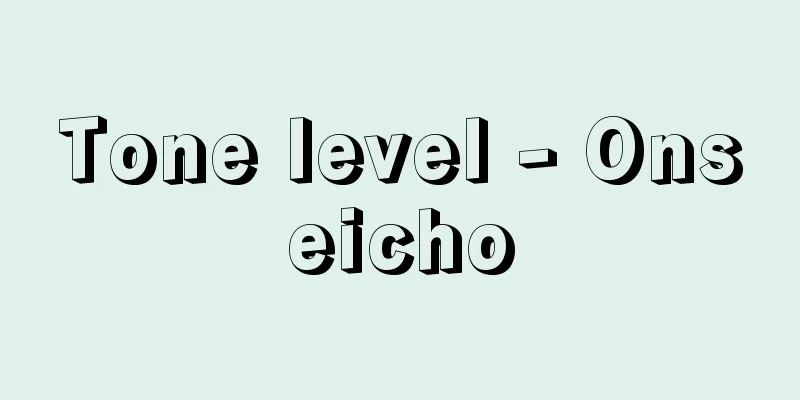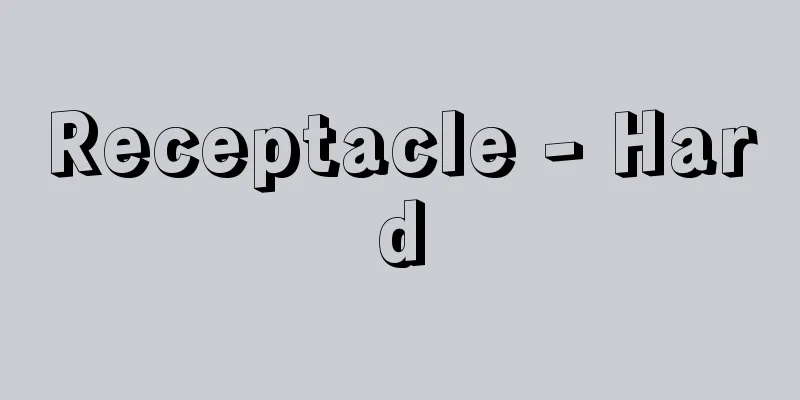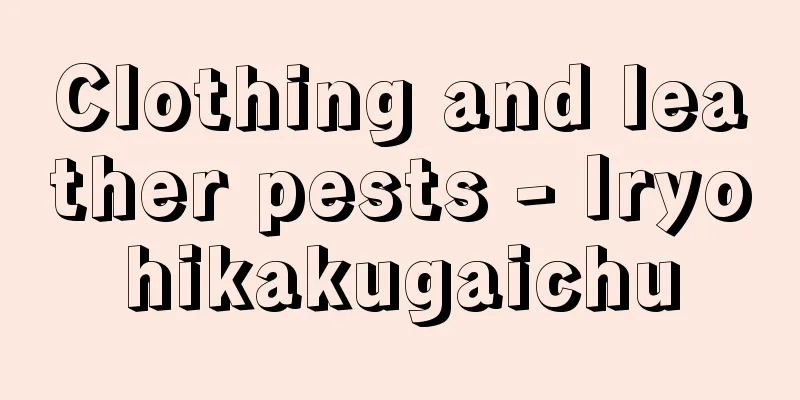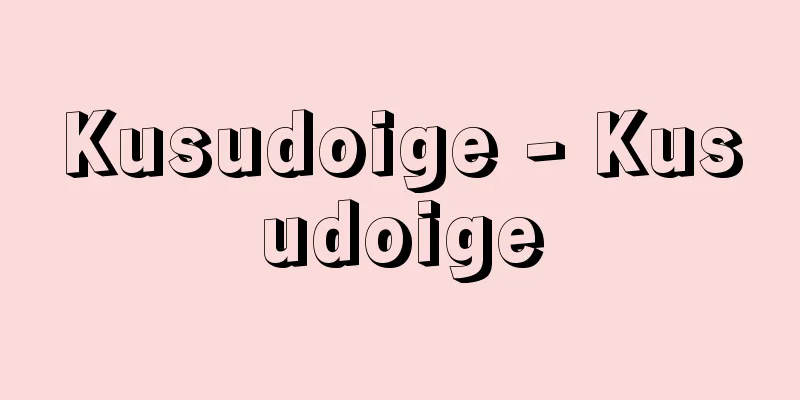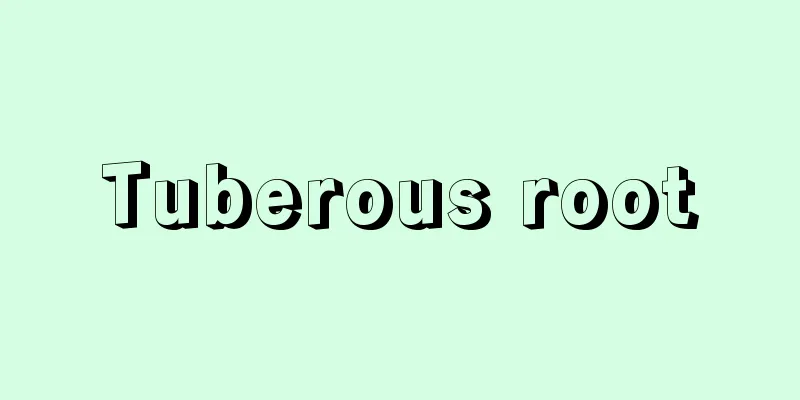Pseudonym - Kana

|
A type of phonetic character. A general term for the unique usage of kanji that was invented to write Japanese, and new characters created based on kanji. The former is called "Manyo Kana" (or "Shin Kana"), and is a usage that discards the meaning of kanji and adopts pronunciation. The latter is divided into two types: "Hiragana", in which all the strokes of kanji are extremely cursive and simplified, and "Katakana", in which only some of the strokes of kanji are omitted. "Kana" was anciently pronounced "Kanna". It is a phonetic change of "karina", with "kari" meaning "temporary" and "na" meaning "character", and can be understood as a counter term to the use of kanji as "mana" (shinji). [Yutaka Tsukishima] Manyo KanaOriginally in China, the terms "Hindu" and "Amitabha" were used to write foreign place names and personal names in India, Central Asia, and other places, and this method was already being used in Japan to write personal names in documents from around the 5th century. In the 8th century (Nara period), it was used not only to write personal and place names, but also words such as verbs and adjectives, and even short sentences, and many works that wrote songs using this method appeared. Examples include the Kojiki and Nihon Shoki from the early 8th century. The Manyoshu, compiled in the mid-8th century, is a collection of over 4,500 waka poems, and Manyogana is the most widely used of them. This can be said in terms of both the volume and the variety of content. Many 8th century documents, such as the Fudoki, Kakyo Hyoshiki, and Butsokuseki Kahi, use Man'yōgana, but in documents from the same period that are primarily for oral recitation, such as Norito and Senmyo, the so-called "Senmyo-tai" style developed, in which Man'yōgana are written in small letters alongside the correct kanji. Furthermore, in the writings of Buddhist monks of the time, annotations of Japanese readings in Man'yōgana are often found. This style was traditionally continued into the following Heian period and beyond, and continued into the early modern period. However, with the invention and development of hiragana and katakana, its usage became more limited. The usage of Man'yōgana can be broadly divided into "Onkana" and "Kunkana". The former is based on the sounds of Chinese characters, such as "Ame" (A rice) and "Wo" (Crow) and "Me" (Crow), while the latter is based on the sounds of Japanese, such as "Yamato" (Yamato). The annotations and songs of the Kojiki and Nihon Shoki all used Onkana, but the songs of the Man'yōshū used both Onkana and Kunkana, and the Kunkana in particular include unique usages such as "Tsurukamo" (crane and duck), "Kuku" (eighty-one), "Sasa" (the voice of kagura), and "Ide" (mountain is full of mountains). "I, Bu, Se, Kumo, Aruka" (fifty, bee, sound, stone, flower, spider, deer) is an example of a deliberate combination of animal names, known as Gisho, but this is also considered a type of Kunkana. Kunkana can also be found in the Kojiki and Nihon Shoki, as well as in the names of gods and people in ancient documents, but for general words, onogana were the more common. Depending on the type of Chinese character sounds that were the basis, onogana could be classified into archaic sounds such as "to" (stop), "ga" (ga), "so" (lantern), and "ya" (moving), go-on sounds such as "nu" (slave) and "mi" (beauty), and kan-on sounds such as "da" (na) and "ba" (polishing), but of these, go-on sounds were used the most. There are also cases where the end of a go-on word is omitted, such as "te" (heaven) (omitting the n from tien), "ra" (ra) (omitting the ng from lang), "ne" (omitting the i from niei), and "ma" (omitting the t from muât). [Yutaka Tsukishima] hiraganaHiragana is a uniquely Japanese syllabary that was created by making all the strokes of Manyo-gana extremely cursive. There are 47 characters in common use today, and 48 characters including "n". The style and Manyo-gana that are thought to be the origin of the characters are as follows: I (I) RO (Ro) HA (Wave) NI (Jin) HO (Protect) HE (Part) TO (Stop) There has long been a theory that the creator of hiragana was Kobo Daishi Kukai, but there is no solid evidence. The earliest examples of hiragana date back to the end of the 9th century, in the early Heian period, but this was several decades after Kukai's death. It is difficult to pinpoint the creator of hiragana, but it is likely that it was created by someone among the literate class of the time, and was not necessarily written by women at first, but rather by male scribes or educated people. From around the end of the 8th century, letters and other documents were written in cursive Man'yōgana, with each character consisting of one sound. Gradually, the style of writing became more simplified, and by the end of the 9th century, the current hiragana style of writing was established. The fact that the imperially commissioned Kokin Wakashū, compiled in the early 10th century, was written in hiragana is seen as evidence that the characters were already perfected and were qualified to appear in public situations. Then, at the end of the 10th century, the Wakan Roeishu was created, which included both Chinese poetry and waka poetry, and it shows the use of both kanji and hiragana. It is said that the development of hiragana was one of the factors that led to the rise of kana literature for women, such as The Pillow Book and The Tale of Genji, in the mid-Heian period. Looking at materials on hiragana handwriting from that time, we can see that until around the end of the 10th century, relatively simple characters were used and there were a relatively small number of letters, but from the 11th century onwards, complex characters increased and the number of types of letters increased. This is thought to be the result of the demand for changes in hiragana characters due to the rise of calligraphy at that time. This trend was passed down for a long time into the Middle Ages and beyond, and the characters have remained almost unchanged since the Heian period to the present day. The scope of use also continued to be the world of women and children, with the tradition of being mainly used by women during the Heian period continuing into the future. After the Kamakura period, there were Japanese translations of Chinese classics written in hiragana, such as the Lotus Sutra and the Analects of Confucius, but these were probably intended for women and children. In the past, hiragana texts were almost entirely written in hiragana, with few kanji characters mixed in, but from the Middle Ages onwards, the number of works that mixed in kanji gradually increased. [Yutaka Tsukishima] KatakanaA syllabary made by discarding some of the strokes of Manyo-gana and leaving some behind. Currently there are 47 types of Katakana characters, with the addition of "n" bringing the total to 48. The usage of the voiced mark "゛" and the semi-voiced mark "゜" is the same as for Hiragana. In the past it was called "Kata-kanna," with "Kata" likely meaning that the character shape is incomplete. The current style and its origin are shown below. A (the radical of the cursive writing of A) [Yutaka Tsukishima] "Reprint of 'Historical Materials on the Development of Kana Script and Kana Character Style' by Oya Toru (1970, Benseisha)" ▽ "'A Study of the History of the Development of Kana'" (included in 'Kasuga Seiji Collected Works 1', 1982, Benseisha)" ▽ "'A Linguistic Study of Ancient Japanese Texts: General Discussion' by Nakata Norio (1954, Kodansha)" ▽ "'Kana' by Tsukishima Yutaka ('The World of Japanese Language 5', 1981, Chuokoron-Shinsha)" Source: Shogakukan Encyclopedia Nipponica About Encyclopedia Nipponica Information | Legend |
|
表音文字の一種。日本語を書き表すために、漢字について創案された独自の用法、および漢字を基にしてつくりだされた新しい文字の総称。前者は「万葉(まんよう)仮名」(または「真(ま)仮名」)といわれ、漢字の意味を捨て発音を採用した用法であり、後者については、漢字の全画を極度に草体化、簡略化した「平仮名」、および漢字の字画の一部だけを省略した「片仮名」の2種がある。「かな」は古く「かんな」と発音した。「かりな」の音転で、「かり」は「仮」、「な」は「字」の意で、漢字を「まな」(真字)といったのに対する語と解せられる。 [築島 裕] 万葉仮名もと中国で、インドや中央アジアなどの外国の地名・人名などを表すのに「身毒」Hindu、「阿弥陀」Amitaのような用法があったが、本邦でもこの方式は、5世紀ごろの文献のなかにすでに人名などの表記に使用されている。8世紀(奈良時代)になると、人名、地名はもとより、動詞や形容詞などの単語や、さらに進んで短い文の表記にも使用され、歌謡をこの方式で記したものも多く出現した。8世紀初頭の『古事記』や『日本書紀』はその例である。8世紀中葉に成立した『万葉集』は、和歌4500余首を集録するが、そのなかで万葉仮名はもっとも盛んに使用されている。それは分量のうえからも、内容上のバラエティーからもいえることである。8世紀の文献には「風土記(ふどき)」『歌経(かきょう)標式』「仏足石歌碑」など、万葉仮名を用いたものが多いが、同じ時期の「祝詞(のりと)」「宣命(せんみょう)」などの口誦(こうしょう)を主とした文献では、正用の漢字に添えて万葉仮名を小書きにした、いわゆる「宣命体」が発達した。さらにまた、当時の仏僧の著述のなかにも、万葉仮名による和訓の注記が往々にしてみられる。このような状態は、次の平安時代以降にも伝統的に継承され、脈々として近世にまで及んだ。しかし、平仮名、片仮名の創案・発達に伴い、その用法は限定されていった。 万葉仮名の用法には大別して「音(おん)仮名」と「訓仮名」とがある。前者は漢字の字音に基づいたもので、「阿(ア)米(メ)」「烏(ヲ)等(ト)咩(メ)」などがそれであり、後者は国語の音に基づいたもので、「八間跡(ヤマト)」などがそれである。『古事記』『日本書紀』などの訓注や歌謡はすべて音仮名を用いたが、『万葉集』の歌では音仮名、訓仮名を併用し、ことに訓仮名のなかには、「鶴鴨(ツルカモ)」「八十一」(クク)、「神楽声」(ササ)、「山上復有山」(イデ)のような特異な用法のものまで含んでいる。「五十(イ)蜂音(ブ)石花(セ)蜘蛛(クモ)荒鹿(アルカ)」などは、故意に動物の名を連ねた例で、戯書(ぎしょ)とよばれるが、これも訓仮名の一種とみられる。訓仮名はこのほか『古事記』や『日本書紀』、古文書の神名・人名などに用例があるが、一般の語の場合は音仮名が多かった。その音仮名も、もとになった漢字音の種類によって、「止(ト)」「冝(ガ)」「巷(ソ)」「移(ヤ)」などの古音、「奴(ヌ)」「美(ミ)」などの呉(ご)音、「娜(ダ)」「磨(バ)」などの漢音の別があったが、そのうち呉音関係のものがもっとも多く用いられた。また、呉音の語尾を省略したものがあり、「天(テ)」(tienのnを省略)、「良(ラ)」(langのngを省略)、「禰(ネ)」(nieiのiを省略)、「末(マ)」(muâtのtを省略)など、その例である。 [築島 裕] 平仮名平仮名は万葉仮名の全画を極度に草書化して生じた、日本独特の音節文字である。現在一般に用いられる字数は47字で、ほかに「ん」を含めて48字となる。その字体と、字源と考えられる万葉仮名は次のとおりである。 い(以) ろ(呂) は(波) に(仁) ほ(保) へ(部) と(止) 平仮名の作者は、弘法(こうぼう)大師空海とする説が古くからあるが、確かな根拠はない。平仮名の古例は平安初期の9世紀末ごろまでさかのぼるが、それは空海没後数十年を経ている。平仮名の作者を特定することはむずかしいが、おそらく当時の識字階級のなかに求むべきであり、当初はかならずしも女性とは限らず、むしろ男性の書記や教養人の手によって発達したのではないかと思われる。8世紀末ごろ以後、書簡文などに、1字1音の万葉仮名を草体化して連ね書いたことがあったが、しだいにその字体の簡略化が進み、9世紀末には、現行のような平仮名字体が成立していたらしい。10世紀初頭の勅撰(ちょくせん)の『古今和歌集』が平仮名によって記されたのは、この文字がすでに完成して、公的場面に登場するにふさわしい資格を備えていた証(あかし)と認められる。ついで10世紀末には、漢詩と和歌を併載した『和漢朗詠集』がつくられたが、そこには漢字と平仮名との併用がみられる。平安中期における『枕草子(まくらのそうし)』『源氏物語』などの女性仮名文学の隆盛は、平仮名の発達が一因をなすといわれる。平仮名の当時書写の資料をみると、10世紀末ごろまでは比較的単純な字体が多く、字母もわりあい少数なのに、11世紀以後にはかえって複雑な字体が増加し、字母の種類も多くなる。これは、当時の書道の隆盛により、平仮名の字体に変化が求められた結果と思われる。その傾向は中世以後にも長く伝えられ、字体も平安時代以来ほとんど変わらぬままに現在に及んでいる。その使用範囲も、平安時代に女性が中心であった伝統が後まで続き、女性や子女の世界に主として行われた。鎌倉時代以後、「法華経(ほけきょう)」や『論語』など、漢文の和訳本が平仮名で書かれたものがあるが、おそらく婦女子の読者を対象としたものであったと思われる。また、古くは平仮名文はほとんど平仮名ばかりで、漢字を交えることが少なかったが、中世以後にはしだいに漢字を混じたものが増加した。 [築島 裕] 片仮名万葉仮名の字画の一部を捨て、一部を残してつくった音節文字。現行の片仮名の字数は47種で、ほかに「ン」を加えて48種となる。濁点「゛」、半濁点「゜」の用法は平仮名と同様である。古く「かたかんな」と称したが、「かた」は字形が不完全との意であろう。現行の字体とその字源を次に示す。 ア(阿の行書体の偏(へん)) [築島 裕] 『大矢透著『仮名遣及仮名字体沿革史料』再版(1970・勉誠社)』▽『「仮名発達史の研究」(『春日政治著作集1』所収・1982・勉誠社)』▽『中田祝夫著『古点本の国語学的研究 総論篇』(1954・講談社)』▽『築島裕著『仮名』(『日本語の世界5』1981・中央公論社)』 出典 小学館 日本大百科全書(ニッポニカ)日本大百科全書(ニッポニカ)について 情報 | 凡例 |
Recommend
Hiroshima Plain - Hiroshima Heiya
An alluvial plain that unfolds in the lower reach...
Rallus aquaticus (English spelling) Rallusaquaticus
…A species of bird in the family Rallidae, or a g...
Frisia Islands (English spelling)
A group of islands along the northern coast of con...
Heki [town] - Heki
An old town in Otsu County facing the Sea of Jap...
Freeze-dried - Tokukanso
This refers to vacuum drying a substance in a fro...
Net worth tax
A type of ordinary property tax, it is levied as ...
Danzo - Danzo
A statue made from sandalwood, a type of fragrant...
Mirin (sweet sake) - Mirin
A sweet yellow liquor made by mixing steamed gluti...
Memorial service for Zen Master Eisai
...In the Honganji and Takada sects, a memorial s...
Kirmanshah - Kirmanshah
...Capital of the province of the same name. Also...
Arne, T. (English spelling) ArneT
...Handel's works (composed by Pepusch) were ...
Koshikibu - Koshikibu
A female novelist in the mid-Heian period. She is ...
Lobby - Lobby (English spelling)
An anteroom attached to the entrance of a confere...
Ch'oe Sihyǒng (English spelling)
[Born] King Sunjo 27 (1827) [Died] 1898. Seoul, Ko...
Tokudaiji Sanenori
Grand Chamberlain to Emperor Meiji. Born on Decem...
